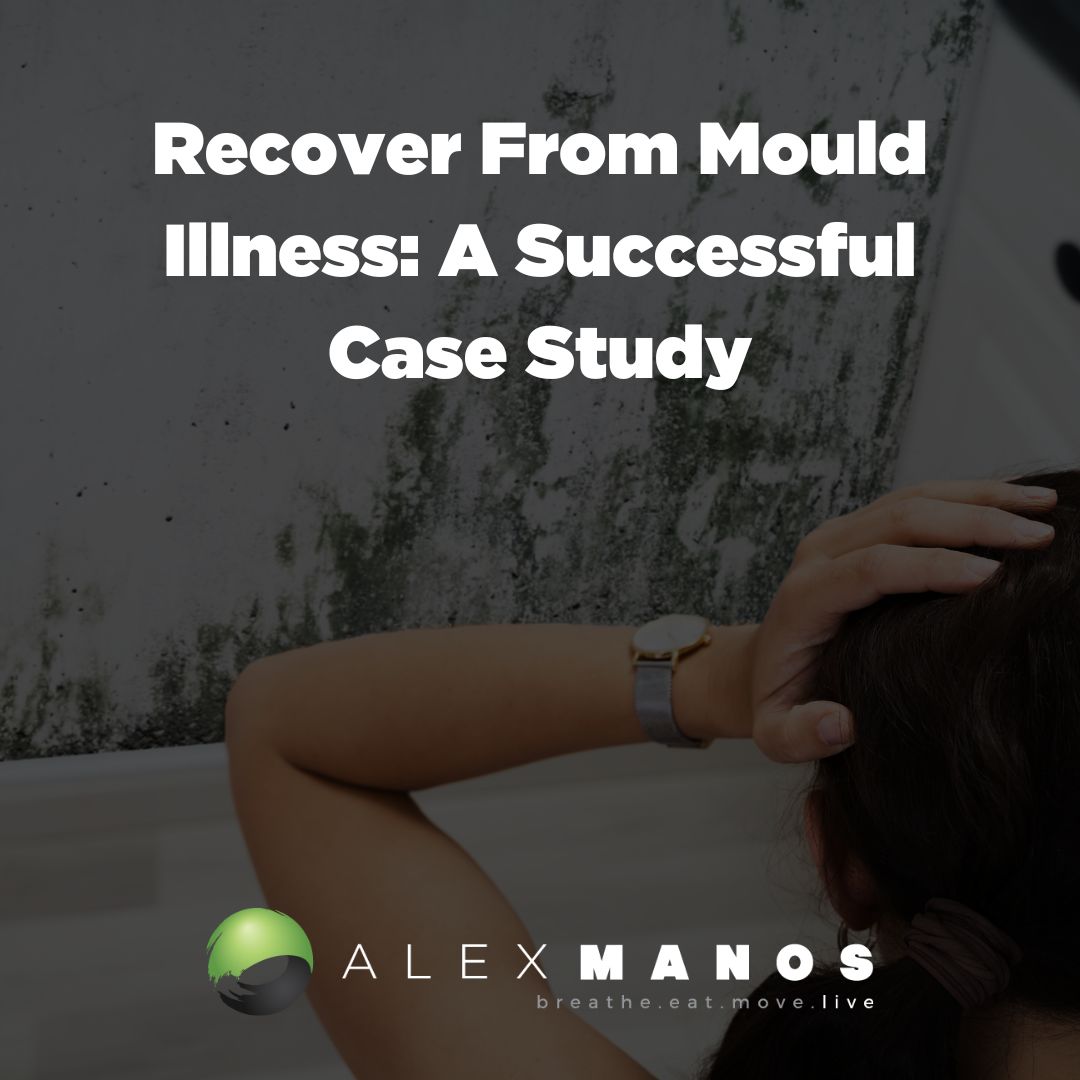Recover From Mould Illness: A Case Study
Welcome to my blog where I summarise a published case report written by Dr. Jill Crista, author of Break The Mold. My hope is that it provides hope to those suffering with mould related illnesses, and helps fellow practitioners understand some of the nuances when it comes to testing and treatment.
Background To The Case Study
The case study revolves around a 53-year-old man who was a previously healthy executive. He had prior diagnoses of: allergies, asthma, pruritus, insomnia, and anxiety. This seemed to start after exposure to a water-damaged home. His symptoms had been slowly getting worse, despite treatment.
When he consulted with Dr. Crista, he was also suffering with a persistent dull headache, bilateral tinnitus, urinary frequency, glove-and-stocking neuropathy, and aggravation of asthma leading to exercise intolerance.
His initial respiratory symptoms started after moving into a historic home, which he had work done on immediately. Interestingly he lived in the property during most of the remodel. The published paper explains that it was later discovered that the home had multiple sites of hidden water damage.
To recover from mould illness, it is essential to use experienced and trusted companies when having an evaluation, or remediation on your house.
Prior treatment included over-the-counter antihistamines for allergies, albuterol inhaler for asthma, and doxepin for mood, pruritus, and insomnia. He occasionally used NSAIDs for headache when needed
Testing Fot Mould Illness
The tests carried out that helped this man recover from mould illness included:
Serum Mould Allergy Testing
The patient was IgE Class II or III positive to several moulds, including Penicillium chrysogenum, Aspergillus fumigatus, Alternaria alternata, Fusarium proliferatum, and Epicoccum purpur.
Lower respiratory culture
This was negative.
Urine Mycotoxin Test
He had already completed a urinary mycotoxin test and detected the excretion of mycotoxins. The test was completed without provocation (the use of glutathione) or dietary restrictions using the ELISA method, which included Aflatoxins, Trichothecenes, and Gliotoxin Derivatives.
One limitation of the urinary mycotoxin test is the possibility that excreted dietary exposure could amplify the results. A review article in the International Journal of Environmental Research and Public Health states that “over 300 mycotoxins have been identified, six (aflatoxins, trichothecenes, zearalenone, fumonisins, ochratoxins, and patulin) are regularly found in food, posing unpredictable and ongoing food safety problems worldwide”.
To minimise the limitation of dietary amplification in the urine, patients are advised to eat a low-mycotoxin diet for three days prior to urine mycotoxin testing.
Another urinary mycotoxin test was ordered without provocation (the use of liposomal glutathione). As Dr. Crista explains in the case study “provocation was not used for the urine test to increase confidence that excreted mycotoxins, if any, were from current exposure.”
Learn more about how to use, and interpret, a urinary mycotoxin test in my blog Mycotoxin Testing: What You Need To Know. Spoiler alert – it may not be as simple as just doing the test!
Products
Visual Contrast Sensitivity (VCS) Test
The patient was found to have decreased visual contrast sensitivity. Dr. Crista explains in the paper how this added to the suspicion of neurotoxic effects, which has been correlated to water-damaged building exposures.
Do an online visual contrast sensitivity test here.
Treatment To Help Recover From Mould Illness
For this 53 year old man to recover from mould illness treatment included dietary changes and supplements, as well as systemic, intranasal, and topical anti-fungals. But this wasn’t all started at once – another important consideration (in my experience clients often want to ‘speed up’ the healing process and believe this can be achieved by doing more – a totally understandable perspective but one that can’t be achieved).
In this case systemic and intranasal anti-fungals were not part of the initial plan to allow time for the diet and supplements to “preempt” possible side-effects of the anti-fungal therapy.
A really important thing to know about mould is that many species will increase their production of mycotoxins when they feel threatened – for example when they are exposed to anti-fungals.
Histamine
In this instance, the focus of the diet and supplements was:
- Immune modulation.
- Reduce histamine sensitivity.
- Support organs of detoxification involved in mycotoxin excretion.
To make this easier for the the patient, Dr. Crista gave him a handout of foods to avoid which were high
in histamine, with particular focus on the two main categories of leftovers and fermented foods.
He was also instructed to increase foods rich in the natural anti-histamine quercetin, foods that might help bind and eliminate mycotoxins, as well as drinks that may help allergy/histamine symptoms.
To recover from mould illness often recovers a personalised approach to food.
Proresolving Mediators
Omega 3’s have been found to be extremely beneficial for both mycotoxin injury and asthma, however fish oil may can exacerbate histamine issues for some. Therefore, it was recommended anti-inflammatory compounds derived from fish oils called proresolving mediators to be used.
Alex’s Recommended Product: SPM Supreme
Turmeric
Turmeric has been used in animal studies to help protect the liver against mycotoxin exposure, and it has broad anti-inflammatory effects in humans in multiple systems.
Alex’s Recommended Product (get 10% off with code alexmanos10): Curcumin 500
Resveratrol
Resveratrol may help reduce allergic asthma and reduces DNA damage in bronchial epithelia, as well as enhancing natural killer cell function.
Resveratrol may reduce overactive bladder through its antioxidant activity. It also addresses neuropathy by combatting known mycotoxin mechanisms.
Alex’s Recommended Product (get 10% off with code alexmanos10): Resveratrol Supreme
Binders
Binders are frequently recommended to recover from mould illness. However, due to the patient’s falling total cholesterol and HDL, a potential risk of the non-specific action of cholestyramine, the pharmaceutical binder was replaced with 2-3 tablespoons of fresh ground flax seeds per day.
Glutathione
While glutathione is often used to recover from mould illness, (you can read my blog Detoxify Mycotoxins With Liposomal Glutathione), it was not considered in this case due its risk of asthma aggravation.
Alex’s Recommend Glutathione Product (get 10% off with code alexmanos10): Liposomal Glutathione
Follow Up
At the eight week follow up, the patient reported what he described as “measurable improvement” in his asthma
symptoms, with reduced use of his albuterol inhaler by an average of 2 days per week. He was able to tolerate low intensity exercise, though it would cause transient global pruritus.
Even though the supplements were primarily targeted to the patient’s chief complaint of asthma, he saw mild improvement in glove-and-stocking neuropathy and therefore sleep, as well as faint improvement in urinary frequency and anxiety. Tinnitus and dull headache persisted. He reported that his allergies seemed to have “shrunk and come to centre” on his nasal passages, noting improved eye, ear, and throat pruritus, necessitating fewer antihistamines. However, he noted slightly more nasal congestion. The
patient also reported improved cognition, which he had not noticed was an issue until it improved.
The jock itch was responding to topical treatment. At this visit, the patient was instructed to continue the plan and add anti-fungal therapy, with emphatic instruction to keep his rescue inhaler close at hand in case of reactions.
Before using the anti-fungals, he was instructed to start taking activated charcoal away from food. As this can be quite constipating for some, he was also told that, if he was still able to have regular bowel movements after one week, he could begin anti-fungals, and continue the charcoal for another two.
Systemic Anti-Fungals
For systemic anti-fungals, he began itraconazole, to account for the significant first-pass effect of the triazoles.
To combat drug resistance to itraconazole, he was also recommended a garlic supplement with concentrated allicillins.
I am in the process of writing a blog about addressing systemic candida infections – make sure your signed up to my newsletter to find out when it’s released.
Intranasal Anti-Fungals
Nasal treatment is fundamental to recover from mould illness..
For intranasal anti-fungal treatment, he was given a compounded nasal solution of nystatin saline which he was told to atomise, and this was alternated with an intranasal colloidal silver nasal spray.
Red Light Therapy
The patient was given a photobiomodulation device to use in the nares as needed for allergic symptoms.
Retest Results
The retest for the IgE mould spore allergy panel showed only one Category 0/1 reaction to Aspergillus fumigatus. Remember initially he was IgE Class II or III positive to several moulds, including Penicillium chrysogenum, Aspergillus fumigatus, Alternaria alternata, Fusarium proliferatum, and Epicoccum purpur.
The IgG and IgE reactions to mycotoxins had also come into the normal range.
The urine mycotoxin test found moderate levels of two mycotoxins, but there was an overall reduction in the excretion of the mycotoxins compared to the previous test. In my experience, and as Dr. Crista comments on within the paper, it’s common for different mycotoxins to excrete on repeat tests, and from different detoxification pathways. Our physiology is forever fluctuating, with different toxins being prioritised at different times.
Continued excretion above controls despite dietary avoidance indicated that he would benefit from continued detoxification support.
Final Outcome
Seven months after his initial consultation “his daily asthma symptoms were significantly improved, requiring his albuterol inhaler only one time in the past four months after moving mulch in his yard, which he suspected was mouldy. This was also one of the only times in that same timeframe that he required antihistamines for allergic symptoms.”
Other symptoms of headache, glove-and-stocking neuropathy, pruritus, urinary frequency, and jock itch had resolved and he was back exercising.
Sleep had improved to such a degree that the patient self-withdrew his medication, and used a combination product containing melatonin 3 mg, L-theanine 200 mg, and GABA 100 mg as needed (which was rare) for sleep.
He had also stopped the topical anti-fungals but was continuing all supplements. Residual symptoms were low grade tinnitus and rare situational anxiety, which he began to attribute to mould exposures at restaurants and hotels.
Further Recommendations
The patient was told to discontinue the itraconazole and continue the garlic for one more month as he tracked symptoms. If there was no increase in prior symptoms, he was told to then stop the garlic also. The intranasal nystatin and colloidal silver were both stopped, at different times. As for the medications, he was encouraged to monitor for and report any returning symptoms.
He was also recommended to continue with both the resveratrol and turmeric at half the dose for another two to three months, but could increase the dose of either if any of his previous symptoms returned.
He was told that he could stop the proresolving mediators whenever he wanted to, and reduce the vitamin D target to 60 ng/ml. It was also reported that he chose to continue the diet, and flax seeds as he felt that they improved his energy and bowel movements.
It’s worth noting that this is a common finding when going, rightly so, on a low histamine diet – energy and bowel movements improve.
Conclusions
It took a fair amount of time, effort, and let’s face it money for this guy to recover from mould illness. There’s no denying this is a challenging area to work in, partly due to the potential financial impact of needing to have your home evaluated and remediated. However I hope it provides some hope, confidence, inspiration and fundmentally awareness that you can heal.
Alex is a certified Functional Medicine Practitioner (IFMCP) and has a MSc in Personalised Nutrition. He is also a breathwork facilitator with a background in personal training and massage therapy. He also runs The Resiliency Program - a 24 week program aimed at building physical, mental, emotional, and spiritual resilience.




